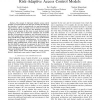Free Online Productivity Tools
i2Speak
i2Symbol
i2OCR
iTex2Img
iWeb2Print
iWeb2Shot
i2Type
iPdf2Split
iPdf2Merge
i2Bopomofo
i2Arabic
i2Style
i2Image
i2PDF
iLatex2Rtf
Sci2ools
ARESEC
2011
2011
An Attribute Based Framework for Risk-Adaptive Access Control Models
—The concept of risk-based adaptive access control (RAdAC, pronounced Raid-ack) has been recently introduced in the literature. It seeks to automatically (or semi-automatically) adjust security risk for providing access to resources accounting for operational needs, risk factors and situational factors. In make progress in this arena we need abstract models analogous to those that underlie the sustained and successful practice of discretionary, mandatory and role-based access control. Such models define a formal structure and components for policy specifications, while allowing for a variety of enforcement architectures and detailed implementation. In this paper we develop a novel approach to capture these characteristics of RAdAC using attribute-based access control. We further show that this RAdAC model can be expressed in the UCON usage control model with suitable extensions, and discuss how other UCON elements not used in this construction could beneficially improve the RAdAC ...
Related Content
| Added | 12 Dec 2011 |
| Updated | 12 Dec 2011 |
| Type | Journal |
| Year | 2011 |
| Where | ARESEC |
| Authors | Savith Kandala, Ravi S. Sandhu, Venkata Bhamidipati |
Comments (0)

